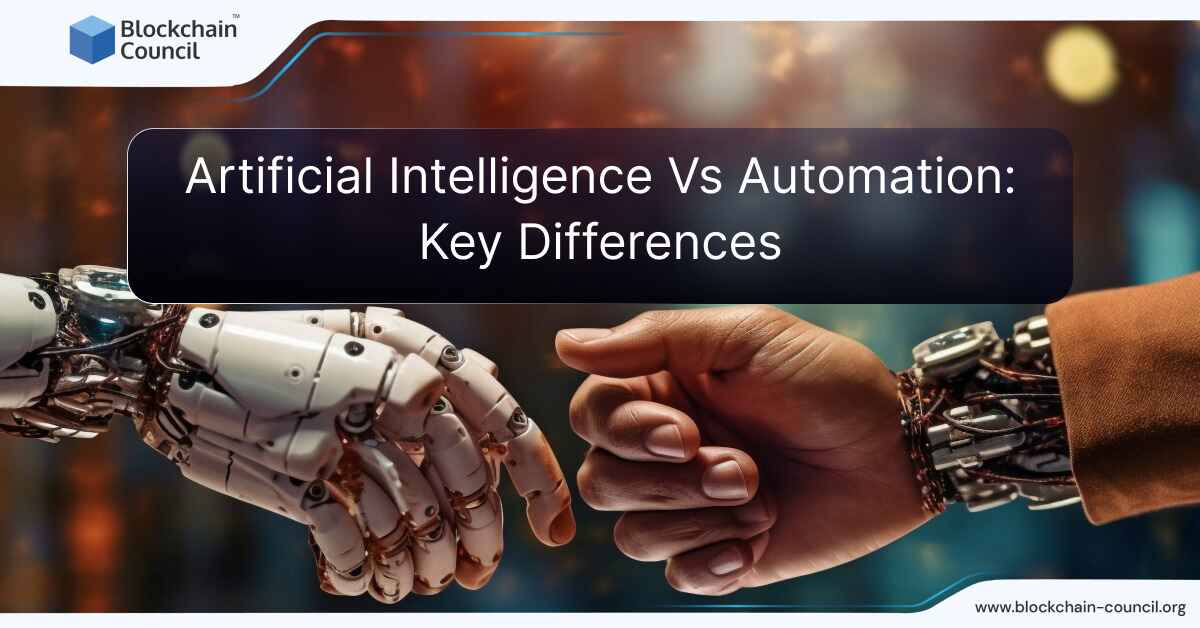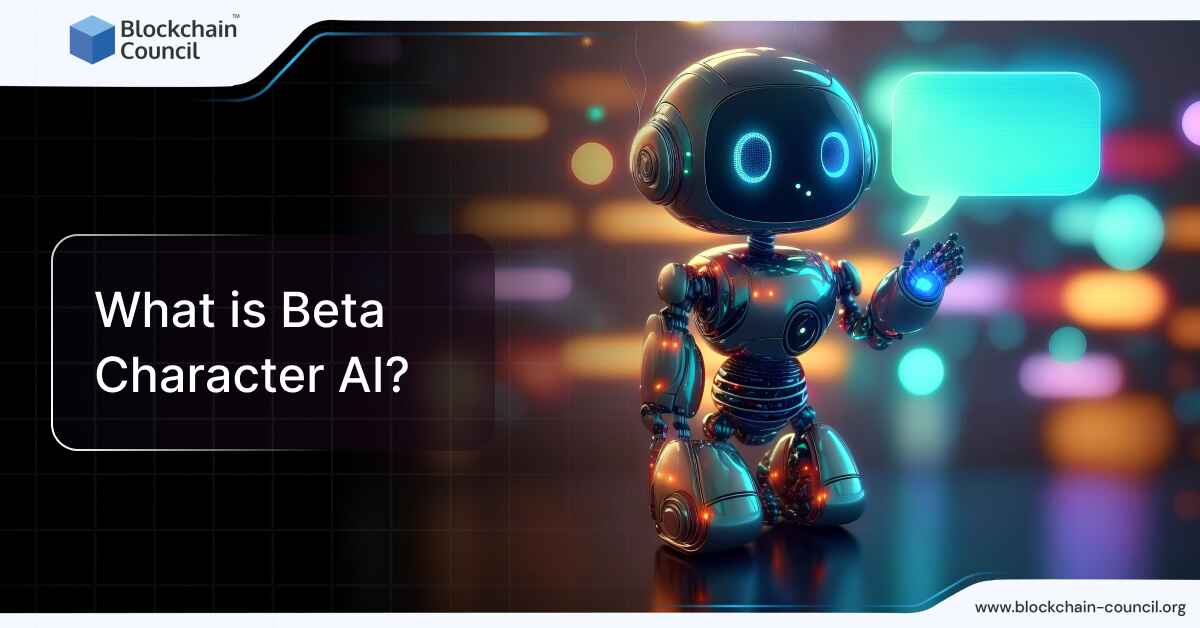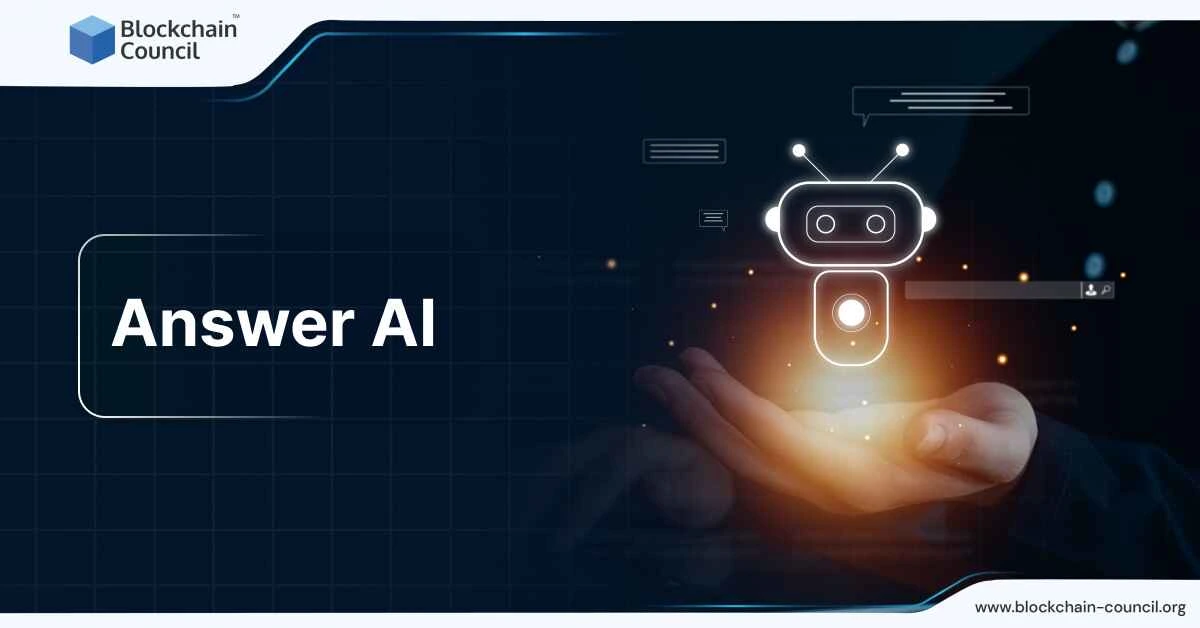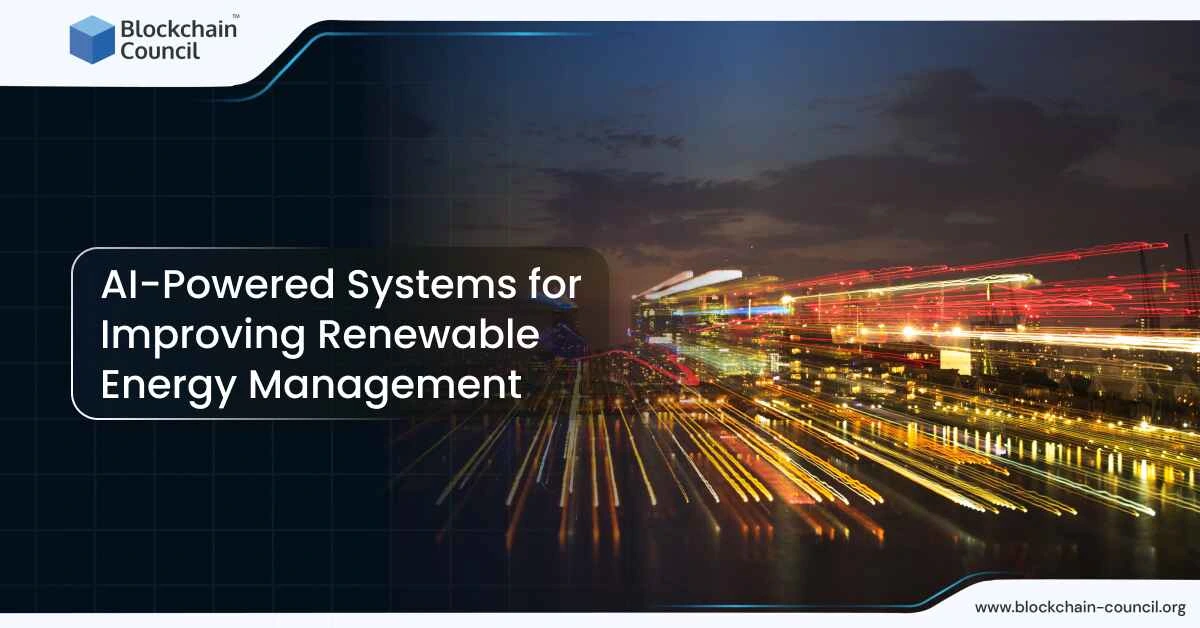
- Blockchain Council
- September 13, 2024
Artificial Intelligence (AI) Vs Automation: Differences
- Learning Vs Repetition: AI is designed to learn and adapt, improving over time through data interaction. Automation operates on pre-set rules and instructions, performing tasks repetitively without adaptation or learning.
- Decision-Making Vs Execution: AI systems are capable of complex decision-making, using cognitive abilities to analyze data and make choices. Conversely, Automation systems follow predefined instructions, focusing on efficient task execution.
- Dynamic Adaptation Vs Static Operation: AI can adjust and make decisions in response to changing conditions. Automation, once configured, remains consistent in its operations according to the set instructions.
- Human Interaction Vs Autonomy: AI often requires some level of human interaction and responds to user inputs. Automation can function entirely autonomously, executing tasks based on predefined rules.
- Broad Vs Specific Applications: AI finds diverse applications across various domains like healthcare, finance, and more, whereas Automation is generally designed for specific tasks like manufacturing processes or automated email responses.
Key Differences Between Artificial Intelligence (AI) and Automation
Nature and Scope
- AI (Artificial Intelligence): Centers around creating systems that can perform tasks requiring human-like intelligence, such as learning, reasoning, and problem-solving.
- Automation: Involves using technology to execute repetitive tasks without human intervention, primarily focused on efficiency and reliability.
Flexibility and Adaptability
- AI (Artificial Intelligence): Exhibits high adaptability, learning from data and improving over time. It’s capable of handling complex, unpredictable tasks.
- Automation: Generally fixed in its operations, performing pre-defined tasks with limited scope for adaptation.
Complexity and Development
- AI (Artificial Intelligence): Involves complex algorithms, machine learning, and often requires significant computing power and data for learning.
- Automation: Relies on simpler, rule-based systems that don’t inherently improve or learn from their operations.
Human-Like Attributes
- AI (Artificial Intelligence): Exhibits human-like qualities such as learning, understanding, and problem-solving. It mimics cognitive functions.
- Automation: Lacks cognitive abilities, focusing instead on the mechanical or logical replication of tasks.
Technological Evolution and Development
- AI (Artificial Intelligence): Continuously evolving, integrating advancements in machine learning, deep learning, and cognitive computing.
- Automation: Evolves in terms of efficiency and scope but remains within the paradigm of executing pre-programmed tasks.
Applications and Scope
- AI (Artificial Intelligence): Broad and diverse applications, from voice recognition and natural language processing to predictive analytics and autonomous systems.
- Automation: Primarily used in manufacturing, data entry, and routine office tasks, focusing on replacing or assisting human labor in repetitive tasks.
Goal Orientation
- AI (Artificial Intelligence): Aims to emulate human cognition and decision-making processes, striving for a level of ‘intelligence’ in operations.
- Automation: Aims at efficiency and productivity, reducing the need for human labor in specific tasks.
How Artificial Intelligence (AI) and Automation Work Together
The interplay between Artificial Intelligence (AI) and Automation is reshaping various industries and redefining traditional approaches to automation.
How AI is Enhancing Traditional Automation
AI brings a new level of intelligence and adaptability to the realm of automation. Unlike traditional automation systems that are primarily rule-based, AI-powered systems can learn, adapt, and make decisions autonomously. This evolution allows for enhanced efficiency and precision in processes, leading to outcomes like reduced errors and the ability to operate continuously without fatigue.
In sectors like healthcare and finance, the precision and reliability of AI in automation play critical roles. For example, AI systems in healthcare can significantly improve diagnostic accuracy and reduce treatment planning time, while in finance, AI can automate complex tasks like legal document analysis, leading to substantial efficiency gains.
Examples of AI-driven Automation in Real-world Scenarios
- In manufacturing, AI systems can monitor production lines in real-time, identifying potential bottlenecks and recommending corrective actions, leading to increased output.
- Retail giants like Amazon utilize AI-driven robots for inventory management and order fulfillment, dramatically improving efficiency.
- In the public sector, initiatives like Singapore’s Smart Nation employ IoT and automation to enhance public services, showcasing the transformative potential of AI-driven automation in governance and public services.
Future Potential of Integrating Artificial Intelligence (AI) with Automation
The future of integrating AI with automation is vibrant and full of potential:
- Innovation in Product and Service Design: AI’s generative models can drastically enhance creativity in areas like product design, leading to optimized prototypes and reduced material usage.
- Healthcare and Pharmaceuticals: In these fields, AI can accelerate drug discovery by simulating molecular structures, thus speeding up the development of new treatments.
- Customization and Personalization: AI’s ability to understand and predict user preferences can revolutionize customer experiences in sectors like retail and entertainment.
Ethical and Societal Considerations
As AI continues to evolve and integrate with automation, it is crucial to address ethical concerns such as algorithmic bias, privacy, and the impact on the workforce. Companies must navigate these challenges responsibly, ensuring AI-driven automation aligns with societal well-being and human values.
Limitations and Challenges of Artificial Intelligence (AI) and Automation
While Artificial Intelligence (AI) and Automation have brought about significant advancements, they are not without their limitations and challenges. Understanding these is crucial for businesses and individuals looking to leverage these technologies effectively.
Limitations and Challenges of Artificial Intelligence (AI)
- Data Dependency and Quality: AI systems rely heavily on data for learning and decision-making. The quality, quantity, and relevance of this data are paramount. Poor data quality can lead to inaccurate or biased AI decisions.
- Ethical and Privacy Concerns: AI’s ability to process and analyze large amounts of personal data raises significant privacy concerns. Ethical challenges include issues of bias, transparency, and accountability in AI decision-making processes.
- Complexity in Implementation: Developing and implementing AI solutions can be complex and resource-intensive, requiring specialized skills and knowledge.
- AI Interpretability and Explainability: Understanding how AI models make decisions can be challenging, leading to a ‘black box’ issue where the decision-making process is not transparent or understandable.
- Integration with Existing Systems: Integrating AI into existing business processes and systems can be challenging and may require significant changes in current workflows.
Limitations and Challenges of Automation
- Lack of Flexibility: Traditional automation systems are often designed for specific tasks and lack the flexibility to adapt to new or changing requirements without significant reconfiguration.
- Job Displacement Concerns: Automation can lead to the displacement of workers, especially in sectors where tasks are highly repetitive and can be easily automated.
- Initial Investment and Maintenance Costs: The cost of implementing automation technologies can be high, including initial investment in equipment and ongoing maintenance and upgrades.
- Technical Failures and Dependency: Over-reliance on automated systems can lead to vulnerabilities, especially if technical failures occur. It also reduces human workers’ engagement with processes, potentially leading to skill degradation.
- Cybersecurity Risks: Automated systems, particularly those connected to the internet, are susceptible to cybersecurity threats, which can lead to significant data breaches or operational disruptions.
Future Trends for AI and Automation
The future of Artificial Intelligence (AI) and Automation is shaping up to be both transformative and challenging. Let’s delve into the predictions and trends for these technologies and their potential convergences.
Generative AI
Generative AI is increasingly playing a central role in various sectors. For instance, it’s being explored in movie production for tasks like lip-syncing and special effects, as seen with the de-aged deepfake of Harrison Ford in “Indiana Jones and the Dial of Destiny.” This trend extends beyond entertainment to marketing and training, where AI tools create endless streams of deepfake avatars. However, this also raises serious questions about the potential misuse of AI in industries like filmmaking and the impact on job roles like actors.
AI-Driven Disinformation Challenges
AI-generated disinformation is a growing concern, especially in the political arena. The ease of creating deepfakes and the increasing realism of AI-generated content make it challenging to discern what’s real online. This can exacerbate political polarization and influence election outcomes, necessitating advanced techniques to track and mitigate such content.
Multitasking Robots
Robotics is evolving with the influence of generative AI techniques. The aim is to develop general-purpose robots capable of performing a broader range of tasks. This shift from specialized robots to versatile models echoes the trend in AI, where large, multimodal models can handle various tasks, from visual to linguistic.
Automation Trends
In 2024, the expansion of intelligent automation (IA) into broader technologies like generative AI is expected. Key automation trends include:
- Integration of generative AI with intelligent automation.
- Focus on digital worker-first processes and all-in-one solutions.
- The growing importance of ethical automation and governance.
- Natural language processing (NLP) becoming crucial for customer interactions.
- Cloud-native platform solutions gaining prominence for their flexibility and control.
Regulatory Landscape for AI
Regulation of AI will likely vary across regions, impacting how organizations deploy AI systems. This includes cloud and software platforms offering bundled GenAI safety and governance packages, and a shift in focus from technology to business outcomes. Additionally, GenAI tools are expected to automate software quality, transforming software testing landscapes.
Long-term Predictions
Looking further ahead, we anticipate:
- The rise of Artificial General Intelligence (AGI) by 2028, which could significantly impact labor markets and our understanding of intelligence and creativity.
- Changes in chip priorities to accommodate AI workloads, influencing the purchase of accelerators like GPUs and FPGAs.
- Business models evolving to monetize GenAI effectively, with a significant portion of G2000 companies leveraging innovative models to double their GenAI monetization potential by 2024.
Conclusion
While Automation and Artificial Intelligence are both pivotal in driving operational efficiency and innovation, their distinct characteristics and applications set them apart. Automation excels in executing predefined, repetitive tasks, thus reducing human effort and error. In contrast, AI brings a layer of intelligence and adaptability, capable of learning, reasoning, and handling complex problems. The future of technological advancement and business efficiency lies in the effective fusion of these two powerful technologies, each complementing the other to create systems that are not only efficient but also intelligent and adaptable. Understanding these nuances is essential for any business or individual looking to harness the full potential of these transformative technologies.
Disclaimer: The content on this platform is for educational purposes only. We do not endorse, recommend, or promote any product. Our articles are based on data from trustworthy sources, and our perspective is neutral and unbiased. Readers should make informed decisions and seek professional advice when needed. We have no affiliations with the products or services mentioned in our content.
Frequently Asked Questions
What are the key differences between Artificial Intelligence (AI) and Automation?
- AI focuses on tasks requiring human-like intelligence, while Automation deals with repetitive tasks.
- AI is adaptable and learns from data, whereas Automation follows pre-set rules.
- AI is complex, involving machine learning and neural networks; Automation relies on simpler, rule-based systems.
- AI exhibits human-like attributes; Automation lacks cognitive abilities.
- AI evolves with advancements like deep learning; Automation improves efficiency but remains static.
- AI has diverse applications; Automation is mainly used in manufacturing and routine tasks.
- AI aims for intelligent operations, while Automation aims at efficiency.
How do Artificial Intelligence (AI) and Automation work together?
- AI enhances Automation by adding adaptability and intelligence.
- AI-powered systems can learn and make autonomous decisions, improving precision.
- In sectors like healthcare and finance, AI enhances accuracy and efficiency in tasks.
- Examples include real-time monitoring in manufacturing and AI-driven robots in retail.
- Integrating AI with Automation offers potential for innovation and customization.
What are the limitations and challenges of Artificial Intelligence (AI)?
- AI heavily relies on quality data for decision-making.
- Ethical concerns include privacy and algorithmic bias.
- Implementation can be complex and resource-intensive.
- AI models may lack transparency and explainability.
- Integration with existing systems can be challenging.
What are the limitations and challenges of Automation?
- Traditional Automation lacks flexibility for new tasks.
- It can lead to job displacement in repetitive tasks.
- Initial costs and ongoing maintenance can be high.
- Over-reliance on automation can result in vulnerabilities.
- Cybersecurity risks are present, especially in connected systems.





































































 Guides
Guides News
News Blockchain
Blockchain Cryptocurrency
& Digital Assets
Cryptocurrency
& Digital Assets Web3
Web3 Metaverse & NFTs
Metaverse & NFTs
